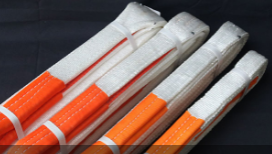The lifting belt has the characteristics of shock absorption, non corrosion, non conductivity, and no sparks in flammable and explosive environments during the lifting process;

Its cross-sectional shape varies with the surface shape of the suspended object, and it is very soft and easy to bend. During operation, it will tightly adhere to or wrap around the suspended object without damaging it, while also reducing the possibility of rebound and injury;
The sling has good resistance to corrosion, as well as high resistance to hydrogen carbonate and most chemical solutions and solvents. However, certain strong acids or alkalis can cause damage to the lifting belt. In most cases, the maintenance of lifting belts can be cleaned by using cleaning agents in cold water.
During the lifting process, it is necessary to avoid being cut by sharp tools. When lifting goods with sharp corners, edges, or rough surfaces, the outer layer of the sling can be protected with leather or polyester to extend its service life.
During lifting operations, it is prohibited to tie the sling or use knotting methods to connect it.
The weight of the lifting belt is light, and compared with a chain of the same load, it only weighs 20% of its weight, so even if it falls from a high altitude, it will not cause personal injury;
The lifting belt is equipped with unique labels and uses international standard colors to distinguish the carrying capacity, making it easy to identify even if the lifting belt is damaged;
Various lifting belt products with a safety factor of 4-8 times can be made according to user requirements;
The elastic elongation of the lifting belt is relatively small, with a working load of less than 3% and a fracture load of less than 10%;
The working temperature ranges from -40 ℃ to 100 ℃.